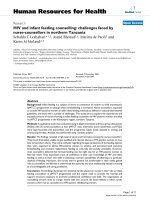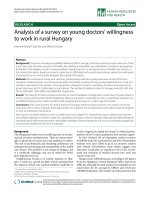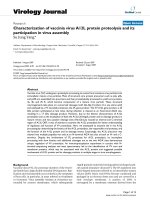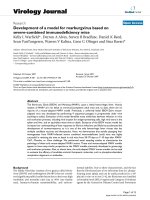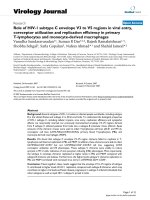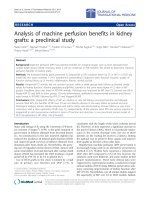báo cáo sinh học:" Analysis of a survey on young doctors'''' willingness to work in rural Hungary pptx
Bạn đang xem bản rút gọn của tài liệu. Xem và tải ngay bản đầy đủ của tài liệu tại đây (448.34 KB, 6 trang )
Girasek et al. Human Resources for Health 2010, 8:13
/>Open Access
RESEARCH
© 2010 Girasek et al; licensee BioMed Central Ltd. This is an Open Access article distributed under the terms of the Creative Commons
Attribution License ( which permits unrestricted use, distribution, and reproduction in
any medium, provided the original work is properly cited.
Research
Analysis of a survey on young doctors' willingness
to work in rural Hungary
Edmond Girasek*, Edit Eke and Miklós Szócska
Abstract
Background: The severe shortage of qualified healthcare staff in Hungary cannot be quickly or easily overcome. There
is not only a lack of human resources for health, but significant inequalities are widespread, including in geographical
distribution. This disparity results in severe problems regarding access to and performance of health care services. In
this context, this report, based on research carried out in 2008, deals with a particularly relevant matter: the willingness
of young doctors to work outside Budapest (the capital of Hungary).
Methods: We conducted a survey with voluntary questionnaires and focus group interviews at each of the four
Hungarian medical schools, concerning career plans and related incentives among young medical doctors. In all, 524
residents responded to the question concerning their willingness to work in rural areas, and there were seven focus
group interviews, with 3-7 participants in each group. The number of residents' places in Hungary were 832, 682, and
785 in 2006/2007, 2007/2008, and 2008/2009, respectively.
Results: The majority of those surveyed would like to work in Budapest or a large town. Fewer than 7% were willing to
work in a town with less than 50 000 inhabitants. Most young doctors would like to work in a teaching hospital (i.e. an
accredited training site for medical students and postgraduate trainees) or a major regional hospital.
Conclusions: The current system of medical training in Hungary tends to produce doctors who want to live in big
cities and work in central hospitals. Rural regions and non-in-patient service alternatives seem either not to be targeted
or seen as unattractive work places.
More doctors would be willing to work in smaller towns and villages if in-hospital training was altered and if doctors
were offered adequate incentives as part of a comprehensive human resource strategy (high salaries, high professional
standards, good working environment, reasonable workload). If these changes do not occur, the existing geographical
and structural imbalances will not be improved.
Background
The Hungarian health sector is suffering from an increas-
ing lack of nurses and physicians. There are severe short-
ages of physicians in some areas and surpluses in others.
The lack of professionals and mounting imbalances can
endanger the functioning and sustainability of the health
care system. This problem is not unique to Hungary, but
is a worldwide challenge, and one to which the WHO
gives high priority [1,2].
Neighbouring Croatia is in similar situation to Hun-
gary. A study was carried out there which concluded that
the majority of final year medical students would like to
work in Zagreb, the capital of Croatia [3], while the three-
quarters of the Croatian population lives outside Zagreb.
In New Zealand, 8% of respondent medical trainees
would like to go into rural practice and 63% of respondent
trainees were more likely to go if an incentive scheme
were offered. Nevertheless, some studies suggest, that
education would play an important role in the recruit-
ment and retention of medical doctors into rural and
remote areas [4,5].
Hungary lacks 2200 physicians, according to the figures
from the Hungarian Central Statistical Office (data from
2006) [6], although the total number per population is not
much below the EU average [6] (280.63 and 315.22 per
100 000 inhabitants). The number of medical doctors that
* Correspondence:
1
Health Services Management Training Centre, Semmelweis University, 2
Kútvölgyi út, Budapest, Hungary
Full list of author information is available at the end of the article
Girasek et al. Human Resources for Health 2010, 8:13
/>Page 2 of 6
are lacking was calculated by the difference between the
filled jobs and unfilled vacancies.
In some areas, geographical and professional, the short-
age is so severe that the security and sustainability of
medical services is threatened. For instance, 162 (out of
6801) family practitioner posts in Hungary are unfilled,
and in small villages these often become long-term
vacancies [7]. The longer a position is vacant, the more
likely it is that patients will register elsewhere and it then
becomes difficult to find family practitioners, as these are
remunerated by the National Health Insurance Fund on a
per capita basis [8]. The high average age of active Hun-
garian doctors (52.33 years, according to the Central Sta-
tistical Office [6]), and the desire of young doctors to
work abroad, further contribute to the worsening short-
age.
The training of the next generation of physicians, and
the success of in-service training, depend on close and
high level cooperation between medical schools, teaching
hospitals, and other sectors of the health services system.
It is important to examine the work options students and
young doctors aspire to, their career plans and the corre-
sponding incentives. Within a few years, they will form
the backbone of the medical system. Without adequate
incentives, there will be severe shortages of staff in some
areas, coupled with surpluses in other areas. Valid and
reliable data are needed to enable policy makers to
develop effective strategies to address these issues.
We have conducted research since 2004 with the aim of
supporting decision makers in defining intervention
options and effective strategies. Here, we report results of
research carried out in 2008, on the willingness of young
doctors to work outside Budapest, the capital of Hungary.
The human resources for health crisis is mainly a prob-
lem in rural areas, and it is particularly severe in small
towns and remote villages. Hospitals and clinics in these
places have struggled for years to attract and retain quali-
fied doctors. Similarly, the lack of family practitioners has
been a serious problem in villages for many years. Many
foreign studies [9-13] have considered how to encourage
doctors to seek employment in remote rural areas. These
studies concluded that success requires a comprehensive,
systematic approach, in which the planning and imple-
mentation of training plays as important a role as other
factors.
It is important to define the concept of rural area which
is used in this study. WHO [2] uses the following defini-
tion of rural area: "'Rural areas' are considered to be those
areas which are not urban in nature. An 'urban agglomer-
ation' refers to the de facto population contained within
the contours of a contiguous territory inhabited at urban
density levels without regard to administrative boundar-
ies. It usually incorporates the population in a city or
town plus that in the suburban areas lying outside of - but
being adjacent to - the city boundaries". In our study we
used a slightly modified version of this definition of 'rural
areas'. We considered those areas rural that are not in the
vicinity of a city having a medical university and/or hav-
ing a high level health care institution.
This paper concentrates on potential effects of training
on the social and professional integration of trainee doc-
tors, focusing particularly on its potential effects on the
expectations regarding future position and location of
their workplace.
Methods
We used survey questionnaires and focus group inter-
views: students from each of the four Hungarian medical
universities completed questionnaires containing sec-
tions on career plans of and on intention to work abroad
[14,15]. In this paper we only analyze results concerning
the geographical mobility of young doctors. We consider
rural areas to include towns which are not capital or uni-
versity cities or county seats, based on the fact that the
higher, progressive level healthcare institutions are work-
ing in the capital and university cities and county capitals
as well.
The research was carried out at the time of the final
examinations of a mandatory course for all resident doc-
tors (during the first year of residency). At these examina-
tions we distributed the questionnaires with the
examination papers, and briefly introduced our research.
Filling in of the questionnaire was voluntary and anony-
mous. Of 785, 713 completed the questionnaire and 524
(73.5%) of the 713 respondents answered the question on
where they intended to work. This represents 66.7% of
the number of resident places offered (785 in 2008). We
analyzed the non-weighted data with SPSS 15.0 software.
US rather than UK terms have been used for the various
kinds of medical practitioner as these correspond more
closely to their Hungarian equivalents.
A resident (Hungarian: rezidens) is a person who has
graduated from medical school and is spending the first
two years of postgraduate training in specialisation.
These positions are centrally financed and offered in one
of the four medical schools. Residents practice medicine
under the supervision of fully-licensed physicians, usually
in a hospital or clinic.
Seven focus group interviews were held [16], each with
3-7 participants: (two groups in Budapest, two in Debre-
cen, two in Szeged, and one in Pécs). The total number of
participants was 30 persons. The members of the focus
groups were volunteers they expressed their willingness
to participate in the later stages of the research project,
providing their accessibility at the end of the question-
naire. We followed up and recruited them for focus
groups this way.
Girasek et al. Human Resources for Health 2010, 8:13
/>Page 3 of 6
The fact that they volunteered indicates a wide range of
aspirations and not only the role of a particular social net-
work. While recruiting for participants of the groups, we
paid attention to the variety of the participants' likely
career choices. To ensure this variety we used a short fil-
ter questionnaire to classify the participants into groups.
The guidelines for the focus groups were developed and
finalised according to recommendations found in the lit-
erature [16], to previous experiences from our research
using questionnaires, and to a pre-test. One of the pur-
poses of the focus groups was to identify the possible
suitable incentives likely to encourage doctors to work in
remote places.
The focus-group interviews were carried out in each
case in a university classroom. For the high level execu-
tion and analysis of information we consulted and worked
with an expert in this field.
The focus-group interviews were recorded, and we
took notes based on these recordings. The recordings
helped us to minimise subjectivity, since each member of
the team listened to them separately, discussing our
thoughts and experiences afterwards. In the course of the
analysis we progressed according to the guidelines, and
endeavoured to include as many verbal citations as possi-
ble. By using focus groups, the researchers were able to
supplement the quantitative results from questionnaires
with personal anecdotes, opinions and experiences. In
this article we have only used the results of the focus-
group interviews as supplements.
This kind of survey and focus group research does not
require ethical clearance in Hungary.
Results
Regarding the survey results, more than one-third of the
respondents said they wanted to work in Budapest,
almost 60% said they wanted to work in a county capital
and only 6.5% said they wanted to work in a smaller town.
Only two wanted to work in a village. In all, 55% wanted
to work in a town of more than 50 000 people (Table 1).
Counties with a medical university (Baranya: Pécs, Cson-
grád: Szeged, Hajdú-Bihar: Debrecen) have a higher den-
sity of physicians, with Budapest having the highest. Our
results indicate that without proper incentives, existing
imbalances in the geographical distribution of physicians
will be maintained, even increased.
The findings of the focus groups were similar to those
of the questionnaires. Almost everybody wanted to work
in a teaching hospital or a major regional hospital. This
suggests that the current lack of doctors in certain areas
will get worse unless action is taken. The factors which
were declared as influencing the choice of workplace
were: salary, professional standards (i.e. a workplace with
a high level of progressive healthcare), working environ-
ment (good infrastructure, rich instrumental back-
ground), workload, size of town, and access to skilled
colleagues and good equipment.
Focus group interviews showed that, if salaries were
high enough, more doctors would be willing to work in
underserved areas. Another factor that attracts residents
to more specialized hospitals is access to more 'serious'
cases. Most of the respondents said that small hospitals
could not provide the kind of professional development
to which they aspire.
Half of participants in the focus groups said they would
be prepared to relocate, if provided with good benefits
and working environment (some would move if the pro-
fessional level was adequate even without benefits). Few
were willing to commute, in contrast to the respondents
to the questionnaire, of whom almost 70% said they were
ready to commute.
The incentive benefits should be as wide-ranging as
possible, similar to those of the Mobility Programme
(Mobilitás Program) [17], a central policy initiative to
facilitate health professionals' mobility in line with needs.
It was launched in 2007, by the Ministry of Health, but
the program failed due to insufficient resources. Desir-
able benefits were free housing or subsidized house pur-
chases, jobs for spouses, suitable places for their children
in schools and crèches, and significantly higher salaries.
Half of residents noted that the current housing situation
binds people long-term to their homes in Hungary. If
someone buys a home and starts paying the mortgage,
they are unable to move for several years.
Discussion
This study found that residents planned to work in places
where lack of medical staff is not a problem and that they
would not go voluntarily to areas where it is a problem.
Central Statistics Office figures from 2005 [18] show that
12 486 of the 35 395 active doctors in Hungary work in
Budapest (35.2%), and the density of active physicians
varies at county level (Table 1). The uneven distribution
of trained professionals between urban and rural areas is
a serious problem in Hungary.
Areas that lack doctors can only attract doctors if a
comprehensive range of incentives is offered [11,12]. In
the absence of effective human resources for health poli-
cies, there will be a permanent lack of doctors in small
villages and towns, socially-disadvantaged areas and
places far away from medical schools and major towns.
Higher salaries could be the contribution of central
government to improve the density of medical doctors.
Doctors' salaries are currently fixed in public sector wage
tables. The official monthly net salary of resident doctors
is about 380 Euros. This amount is significantly lower
than what most university graduates earn at the start of
their career (for example as an economist, engineer or
lawyer).
Girasek et al. Human Resources for Health 2010, 8:13
/>Page 4 of 6
Table 1: Responses to the question "Where would you like to work?"; geographical distribution of active physicians in
Hungary, by location
County N % County Density of active
physicians (number/
10.000 inhabitants)
Budapest 192 36.6 Budapest 69.4
Baranya 61 11.6 Baranya 46.6
Bács-Kiskun 15 2.9 Bács-Kiskun 24.5
Békés 7 1.3 Békés 22.1
Borsod-Abaúj-
Zemplén
81.5Borsod-Abaúj-
Zemplén
22.1
Csongrád 62 11.8 Csongrád 49.0
Fejér 9 1.7 Fejér 7.7
Győr-Moson-Sopron 17 3.2 Győr-Moson-Sopron 27.1
Hajdú-Bihar 42 8 Hajdú-Bihar 39.7
Heves 13 2.5 Heves 22.1
Jász-Nagykun-Szolnok 5 1.0 Jász-Nagykun-Szolnok 21.3
Komárom-Esztergom 1 0.2 Komárom-Esztergom 22.7
Nógrád 6 1.1 Nógrád 20.6
Pest 21 4.0 Pest 15.7
Somogy 15 2.9 Somogy 25.4
Szabolcs-Szatmár-
Bereg
30.6Szabolcs-Szatmár-
Bereg
19.0
Tolna 10 1.9 Tolna 22.5
Vas 19 3.6 Vas 28.3
Veszprém 11 2.1 Veszprém 24.2
Zala 7 1.3 Zala 24.2
Total 524 100 Country average 32.3
Girasek et al. Human Resources for Health 2010, 8:13
/>Page 5 of 6
Medical training and residency periods take place in
universities and teaching hospitals, which are the best-
equipped hospitals in Hungary. It is hardly a surprise that
doctors used to working with the best equipment are
reluctant to work where it is lacking. Young doctors con-
sider it important to be able to treat patients to the best of
their ability, which they perceive as less possible in
smaller hospitals.
One of the main benefits of medical students gaining
not only academic, but also first-hand practical experi-
ence of various specialties during their graduate training
is that they have the option to choose the one that best
suits them [10,13]. By analogy, the proposed system of
medical students and young doctors doing their practical
training partly in rural areas might also be effective [4,5]
in providing insight into different professional settings.
This could increase the knowledge, familiarity and conse-
quently support the consideration of different profes-
sional surroundings over the course of postgraduate
orientation, and could usefully contribute to the transfor-
mation of future ideas regarding workplace.
Five of the seven focus groups mentioned that spending
less time on on-call duties could also be a useful incen-
tive, as in New Zealand [19], but all said that money was
the only really effective incentive, and that they would
move to remote areas if they received 3-5 times more pay.
In accordance with a WHO paper [2], our study also sug-
gests that financial incentives alone are not sufficient and
have to be supplemented by adequate living conditions,
for example providing free housing, jobs for spouses and
good schools.
This is true wherever they come from, as they have all
become accostomed to city life during their time at medi-
cal school. City life obviously does not only include the
workplace but also other assets (good schools, theatres,
etc.) and proximity to in-service training schemes. As
many residents see their future in terms of family life,
they place great importance on ensuring the best possible
family life and future for their children, along with their
own career development.
Conclusions
In Hungary, young doctors see their future in major cities
and in specialized hospitals. This is not surprising, given
that medical schools are located in cities and that medical
students become accustomed to urban life during their
six years at university. Additionally, the practical training
of students and residents almost always takes place in
well-equipped teaching hospitals, where they become
familiar with the best equipment available in the country
and with the most 'interesting' cases. Furthermore,
would-be specialists do their compulsory residency in
accredited hospitals. Training young doctors at least
partly in underserved areas could familiarise them with a
life as a rural doctor, and possibly reduce resistance to
working outside cities.
So it would be an appropriate arrangement to reform
the system of medical training, so that the students and
the trainees could practice their profession and speciality
in rural and remote areas for some weeks. This way they
give insight into different professional settings.
In education, the most appropriate arrangement would
be the elaboration of a complex and comprehensive sys-
tem of incentives, containing both financial and non-
financial incentives. For example: higher salary in rural
areas, housing support or favourable housing loans,
reduction in on-call work, guaranteed time out of prac-
tice and consideration of options for partners and chil-
dren.
Suitable incentives are also needed, as part of a compre-
hensive and sustainable human resource for health strat-
egy to achieve demand-driven distribution of young
medical doctors in a reasonable time period.
Competing interests
The authors declare that they have no competing interests.
Authors' contributions
EG conceived of the study, participated in the design of the study, carried out
the study and performed the data and focus group analysis. EE conceived the
study, participated in the design of the study, carried out the study and pro-
cessed the literature, helped draft the manuscript and analysis of focus groups.
MSZ conceived of the study and made substantial contributions to conception
and the interpretation of the results. All authors read and approved the final
manuscript.
Acknowledgements
We acknowledge Gilles Dussault's input through his review of this manuscript.
The research project was made possible by a grant (OFA/7341/0032) from the
Hungarian National Employment Foundation (Országos Foglalkoztatási
Közalapítvány).
Author Details
Health Services Management Training Centre, Semmelweis University, 2
Kútvölgyi út, Budapest, Hungary
References
1. Working Together for Health: The World Health Report 2006. World
Health Organization; 2006.
2. Dolea C, Stormont L, Shaw DMP, Zurn P, Braichet JM: Increasing access to
health workers in remote and rural areas through improved retention.
2009 [ World
Health Organization
3. Polasek O, Kolcic I, Dzakula A, Bagat M: Internship workplace preferences
of final-year medical students at Zagreb University Medical School,
Croatia: all roads lead to Zagreb. Human Resources for Health 2006, 4:7.
4. Peach: Comparison of rural and non-rural students undertaking a
voluntary rural placement in the early years of a medical course.
Medical Education 2000, 34:231-233.
5. Curran V, Rourke J: The role of medical education in the recruitment and
retention of rural physicians. Medical Teacher 2004, 26:265-272.
6. Hungarian Central Statistical Office: Yearbook of Health Statistics 2006
Budapest: Hungarian Central Statistical Office; 2007.
7. Grósz A, Papp R: Back to the Future Labour Market Challanges in the
System of General Praticioners (Vissza a jövőbe Munkaerőpiaci
kihívások a háziorvosi rendszerben). HáziJogOrvos 2008, 1:.
Received: 31 August 2009 Accepted: 18 May 2010
Published: 18 May 2010
This article is available from: 2010 Girasek et al; licensee BioMed Central Ltd. This is an Open Access article distributed under the terms of the Creative Commons Attribution License ( which permits unrestricted use, distribution, and reproduction in any medium, provided the original work is properly cited.Human Resources for Health 2010, 8:13
Girasek et al. Human Resources for Health 2010, 8:13
/>Page 6 of 6
8. Gaál P: Health Care Systems in Transition - Hungary Copenhagen: European
Observatory on Health Systems and Policies; 2004.
9. Dussault G, Franceschini M: Not enough there, too many here:
understanding geographical imbalances in the distribution of the
health workforce. Human Resources for Health 2006, 4:12.
10. Rabinowitz HK, Diamond JJ, Markham FW, Paynter NP: Critical Factors for
Designing Programs to Increase the Supply and Retention of Rural
Primary Care Physicians. JAMA 2001, 286:1041-1048.
11. Sempowski IP: Effectiveness of financial incentives in exchange for rural
and underserviced area return-of-service commitments: systematic
review of the literature. Canadian Journal of Rural Medicine 2004, 9:82-88.
12. Lehmann U, Dieleman M, Martineau T: Staffing remote rural areas in
middle- and low-income countries: A literature review of attraction
and retention. BMC Health Services Research 2008, 8:19.
13. Henry J, Edwards B, Crotty B: Why do medical graduates choose rural
careers? Rural and Remote Health 2009, 9:.
14. Sik E: Foundation Concepts of Research on Migration Potential (A
migrációs potenciál kutatásának alapfogalmai). In To Go or To Stay?
Preference Act and the Migration Expectations (Menni vagy maradni?
Kedvezménytörvény és a migrációs várakozások) Edited by: Örkény A.
Budapest: Hungarian Academy of Sciences Research Institute of Ethnic
and Minorities; 2003.
15. Starkiene L, Padaiga Z, Reamy J, Dickuté J: Planning of Human Resources for
Health: The Lithuania Experience Kaunas: Office of Dr. Jolanta Dickuté in
Lithuania; 2006.
16. Siklaki I: The Focus Group Method, Foundation Method of Quanitative
Public Opinion Research (A fókuszcsoport módszer, a kvalitatív
közvélemény-kutatás alapmódszere). Budapest: Kossuth Kiadó; 2006.
17. Eke E, Girasek E: Mobility Program (Mobilitás Program). Orvosok Lapja
2007, 2007/12:.
18. Office HCS: Yearbook of Health Statistics 2005 Budapest: Hungarian Central
Statistical Office; 2006.
19. Hill D, Martin I, Farry P: What would attract general practice trainees into
rural practice in New Zealand. New Zealand Medical Journal 2002, 115:.
doi: 10.1186/1478-4491-8-13
Cite this article as: Girasek et al., Analysis of a survey on young doctors' will-
ingness to work in rural Hungary Human Resources for Health 2010, 8:13
